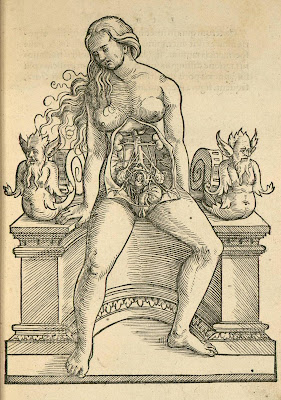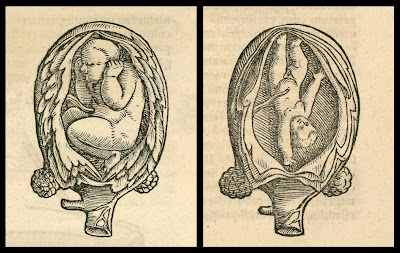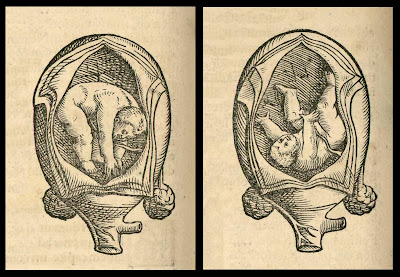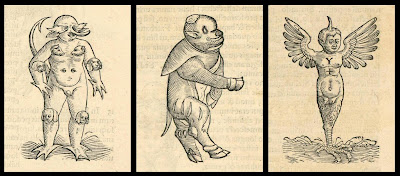"The old world is dying away,and the new world struggles to come forth:now is the time of monsters."[attributed to Antonio Gramsci] {source}






















[click images for much enlarged versions : some of the baby-in-womb images have had the surrounding snips of text removed]
I had half-drafted a sarcastoamusing spiel involving placenta boom boxes, liver umbrellas and the vagaries of horizontal folk dancing but then I discovered the illustrations from one of the 3 books above are actually available elsewhere and I lost the urge to continue. So this becomes the half-hearted post instead.
'De Conceptu et Generatione Hominis' by Jacob Rueff (1554) has just been posted to the University of Strasbourg [link updated Feb. 2013]. I think it's the only complete copy online. 2 of the images above (2nd pregnant woman anatomy and midwife delivering baby) are from a 1580 edition (source). This is the (?)first textbook on midwifery. [see also: Lilly Library medical book exhibition/bibliography at Indiana University]
I want to know what is the device hanging off the belt at the back of the midwife? Does she play the bagpipes I wonder?
The first image in this post comes from another edition - among the Bibliothèque Interuniversitaire de Médecine {BIUM} exhibition site on Rueff (Rüff) [from 'Les Monstres'] .
Incidentally, the triumvirate of monsters seen above are symbolic illustrations of abnormalities that occurred in actual births in the 16th century. I believe these are the originals woodcuts - I've posted copied versions from later books before. 'De Conceptu..' has a number of illustrations of the more realistic birth defects too, if that is your thing.
The foetal skeleton illustrations come from unquestionably the most bizarre anatomy book of the renaissance/early modern era. 'Thesaurus Anatomicus' by Frederik Ruysch (1601) is available in its entirety also from BIUM (I, II). The book precipitously straddles both taste and genre as it presents the anatomical collection of Ruysch as a form of wunderkammer or cabinet of curiosity. There was a twisted mind behind some of the illustration arrangements. This is carnival medicine.
Finally, the last 3 dual images above are from Jacopo Berengario da Carpi's 'Isagogae Breves Perlucidae ac Uberrimae in Anatomiam Humani Corporis...' from 1523. I nabbed these images from BIUM which posted the whole book online in recent times. But all the illustrations - better quality too - are available at Historical Anatomies on the Web. So it goes..


9 comments :
Incredible. Thank you as usual for making these pictures available online. I refer my design students to this blog for inspiration.
the degree of abstraction the artist works with is just amazing. he draws the structure of the internal organs and not what he sees in a dissection, as if he was making a map of the human body instead of a picture. its so interesting that the representations are simple, but highly schematic and highly descriptive at the same time. thats quite unusual nowadays and maybe the way in which were educated visually makes it hard to achieve. i want to learn my anatomy this way.
i love how it looks like the female organs are raspberry vines.
This sort of thing makes any desire to produce offspring simply wither away, although I rather like the images of the manikins taking up diverting poses in the womb. It always does amaze me how even in the Renaissance people had the most peculiar notions of how women's innards were put together, although I think Thomas Laqueur does go a little far with his (well illustrated) hypothesis that the female sexual organs were imagined to be the male organs turned inside out and internalized.
Why, however, must we be deprived of the "placenta boom boxes, liver umbrellas and the vagaries of horizontal folk dancing"? Inquiring minds would like to know more about these topics, which would go so nicely with the skeletons.
Cheers all! I wonder if this abstraction method is indicative of the actual knowledge about 'innards' (at least by anatomists) or just a reflection of the drawing style of the times. Maybe a little of both.
You are all probably better off that my enthusiasm for a humorous slant withered on the vine. The extent of 'my' presence around here is inversely proportional to the quality of the site...or something.
Well, it's that when you do add something wild of your own, it's always interesting in its own right. As a spice, not the main menu. (The fish couturier has rightly been allowed.)
For the record: A 1580 version of 'De Conceptu..' has been posted online at BSB. I haven't checked it out to see if there are any differences to the Strasbourg copy.
You ask: "I want to know what is the device hanging off the belt at the back of the midwife? Does she play the bagpipes I wonder?"
Looks like a purse and perhaps an early version of what we now call a "pinard" fetoscope (check online for photos as they are still manufactured for midwives). Also let's remember that these diagrams are as accurate as they are due to dissection of pregnant impoverished women...and some may not have died "naturally".
Thanks. I think I'm now convinced it's like a tool bag/belt. It could be the head of a fetoscope - as you say - dangling down from the middle. Although it's a not an overly detailed illustration, the protrusion from the "bag" on the right is of a different shape (shadow makes me think catheter pump of some sort?). I don't know that I've ever seen or heard of any earlier different shaped fetoscopes. That's hospital but not museum knowledge, I'll grant. It looks like a cork in a bottle at the top (and behind) the "bag" too. Cheers.
Post a Comment
Comments are all moderated so don't waste your time spamming: they will never show up.
If you include ANY links that aren't pertinent to the blog post or discussion they will be deleted and a rash will break out in your underwear.
Also: please play the ball and not the person.
Note: only a member of this blog may post a comment.